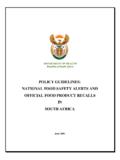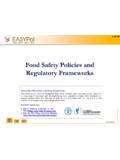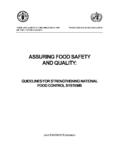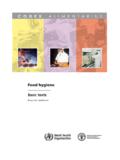Transcription of The occupational hygiene implications of the use of ...
1 Prepared by the Health and safety Laboratory for the Health and safety Executive 2014 Health and safety ExecutiveThe occupational hygiene implications of the use of diacetyl in the food flavouring and fragrance industriesRR1021 Research ReportVince Sandys LFOH, Gordon Smith CMFOH, Priti Shah LFOHand Ian PengellyHealth and safety LaboratoryHarpur HillBuxtonDerbyshire SK17 9 JNDiacetyl is imported predominantly for use in formulations in the food flavouring industry. There have been reports, mainly in the USA, of damage to the respiratory system caused by inhalation. This report presents the findings of a small study to investigate exposures to diacetyl amongst workers employed in the food flavouring and fragrance industries. The report also includes from previous HSE/HSL visits. Exposures to diacetyl are generally of short duration, nonetheless, there is potential for workers to be exposed to airborne levels above those recommended by the EU Scientific Committee on occupational Exposure Limits (SCOEL) of (8-hour TWA) at the time of the study.
2 Following completion of this report, EU (SCOEL) have tabled new proposed limits of ppm (8-hour TWA) and ppm (15-minute TWA). There is currently no UK Workplace Exposure Limit (WEL). Personal exposures to diacetyl for this study ranged from to ppm (8hr TWA) and to (15min TWA). Local exhaust ventilation (LEV) was provided during most diacetyl processes. The effectiveness of LEV control was variable. This was mostly due to inappropriate LEV hood design relative to the process. The respiratory protective equipment (RPE) used was, in most cases, the correct type, however in some cases the assigned protection factors offered (10 & 20) may not reduce exposures to below the SCOEL proposed limits. Deficiencies in the face-fit testing, training and management of RPE were refer to hierarchy of control measures including procedural measures, and currently available HSE report and the work it describes were funded by the Health and safety Executive (HSE).
3 Its contents, including any opinions and/or conclusions expressed, are those of the authors alone and do not necessarily reflect HSE policy. The occupational hygiene implications of the use of diacetyl in the food flavouring and fragrance industriesHSE BooksHealth and safety Executive Crown copyright 2014 First published 2014 You may reuse this information (not including logos) free of charge in any format or medium, under the terms of the Open Government Licence. To view the licence visit , write to the Information Policy Team, The National Archives, Kew, London TW9 4DU, or email images and illustrations may not be owned by the Crown so cannot be reproduced without permission of the copyright owner. Enquiries should be sent to are due to the owners and management teams of each site visited for their support of this work, and also to the operatives who explained the processes and agreed to participate in the monitoring exercises carried iii EXECUTIVE SUMMARY Aim This work was commissioned as a result of the findings of preliminary research carried out by HSL in 2010, which showed that diacetyl was widely used in the flavouring industry.
4 This earlier research was undertaken in 2010 following reports of ill health to workers exposed to diacetyl in the USA. The aim was to quantify exposure to diacetyl and assess the standard of control in the GB food flavouring industry by visiting 18 sites where diacetyl was said to be used. As many of the sites originally listed had ceased handling/using diacetyl, the decision was made to summarise the data collected from this study and to include other data from earlier HSL research and Health and safety Executive (HSE) sector visit reports. Main Findings 18 sites were put forward by HSE as potential participants in this research; visits were only possible at three. The reasons for this included: Overseas HQ refused permission for the site to participate in this study (three sites); Sites had ceased using/handling diacetyl (9 sites); Site visited under previous research project (two sites); Site enforced by local authority (one site); At the three sites visited where neat diacetyl is used to make flavours or fragrances, it was reported to HSL that the use of diacetyl was very infrequent (< once a day) and the amount used was typically small (<200g).
5 Customer demand dictated what products were manufactured and the quantities produced at any given time. At all the sites there was capacity to produce much larger quantities of products containing diacetyl than was witnessed during the visits. It was also reported at all three sites visited that the demand for diacetyl products had reduced and that new formulations containing diacetyl were no longer developed. Results from air monitoring indicated that there is potential for the EU (SCOEL) proposed long-term exposure limit (8-hour TWA) of * to be exceeded, even when exposure times are short and quantities handled small. This applied to sites where flavours were produced using neat diacetyl as well as sites using dilute solutions. The highest exposures were measured during the spray drying of liquid formulations to manufacture powdered products. Exposure control was predominantly reliant on local exhaust ventilation (LEV) with fixed or movable capturing hoods and by using personal protective equipment including tight fitting respirators fitted with organic vapour filters.
6 Limitations in the efficiency of the control measures were found at all the sites visited. With LEV systems, the design iv of the hoods did not fully match the process and/or it had not been applied to all the emission sources. It was found that face fitting had not been carried out for tight fitting respiratory protective equipment (RPE) and some deficiencies were found in RPE maintenance/management. Findings and air monitoring results from previous research visits (four sites) and other HSE visits (two sites) were reviewed and found to be broadly similar to those of this recent work. * At the time of issue the SCOEL proposed exposure limits had been revised to ppm ( mg/m3) 8-hour TWA and ppm ( mg/m ) 15-minute STEL. These limits were being considered in a European Consultative Document. CONTENTS PAGE 1. INTRODUCTION .. 1 2.
7 SITE VISITS .. 3 Assessment of Controls 3 Air Sampling 3 3. FINDINGS .. 4 Site Visits 4 Previous HSE Data 7 Tabulated Summary of all Available Data 9 4. DISCUSSION .. 11 5. CONCLUSIONS .. 13 6. RECOMMENDATIONS .. 14 7. REFERENCES .. 16 8. APPENDIX: MEASUREMENT OF DIACETYL BY THERMAL DESORPTION .. 18 Introduction 18 Preparation of Calibration Standards 19 Storage Tests 19 Breakthrough Test 19 Limits of Detection 20 1 1. INTRODUCTION Diacetyl is a volatile liquid that occurs naturally in small amounts in butter and fermentation products. It is also called by its chemical name 2,3-butanedione (CAS No 431-03-8). It is manufactured outside Great Britain and imported predominantly for use in formulations by the food flavouring industry, where it is used to impart a buttery creamy taste.
8 There have been reports of damage to the respiratory system caused by inhalation exposure to diacetyl, mainly in the USA. Exposure to high concentrations of diacetyl vapour can have a catastrophic effect on the airways, and the resulting disease is known as bronchiolitis obliterans . There is no GB Workplace Exposure Limit (WEL) or US Threshold Limit Value (TLV) for diacetyl; however, the EU Scientific Committee on occupational Exposure Limits (SCOEL) has recommended an occupational exposure limit of *[1] The National Institute for occupational safety and Health (NIOSH) in the USA has recommended that exposure should be kept below (5ppb) averaged over a forty hour week, and a short-term exposure limit (STEL) of (25ppb).[2] Following the publication of several research reports[3,4,5,6,7,8] linking diacetyl to serious lung damage ( bronchiolitis obliterans ) an HSE policy-led working group tasked the relevant HSE sectors and HSL to find out more about the use of diacetyl and the exposures of workers in the industry.
9 Initial research carried out by HSL in 2010[9] as part of an HSE-funded research project called Exploratory work to inform enforcement decisions (EXTEND) showed that use of diacetyl was widespread and that exposures were often not as low as the proposed European SCOEL ( ). It also highlighted that, although controls measures had been implemented, these were not always completely effective. Literature searches carried out by HSE revealed very little about the extent of use, or the potential exposure risk of workers, in the GB. The findings from the EXTEND work combined with the lack of available information on the use of diacetyl and the risk posed to the health of people using it, led to the commissioning of this work. The stated aim of this work was to quantify diacetyl exposure and assess effectiveness of control in the UK food flavour manufacturing industry.
10 This was to be done by measuring diacetyl exposures and assessing the effectiveness of exposure controls at a total of 18 locations. The sites proposed for inclusion in this research were identified by searching HSE records and by using publically available search facilities. Out of the 18 sites, most had either ceased using/handling diacetyl or moved production abroad. 2 Only three of the sites were able to participate in this study. This report summarises the findings from the visits and includes the main findings from previous research and results from other HSE visits to companies where diacetyl was used. In total this report includes data from a total of nine separate sites visited between May 2009 and October 2012. *At the time of issue the SCOEL proposed exposure limits had been revised to ppm ( mg/m3) 8-hour TWA and ppm ( mg/m ) 15-minute STEL.













